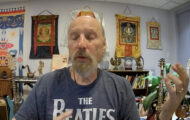Experiencing Real Joy Part 2 – The Story Gap
Happy Monday!
I hope you are all well, and that you enjoyed part one of this three-part series on experiencing real joy. Today, we will explore the story gap.
When we are in a state of coherence – harmony, our inner experience, perceptions and self-dialogue is congruent with the story we tell others.
When we are in a state of congruence, there is no shadow or “binding energy” being created, and we manifest efficiently.
The greater the gap, imbalance, incoherence or chaos in the story we tell ourselves, and the story we tell others, the greater the likelihood of conflict, fatigue, anxiety, depression, illness and disease.
I begin my vlog presentation by sharing the following key points:
– Our “story” = our “living myth”
Our myth is the story we tell ourselves, and is the ideology behind the choices we make, for better or worse. Most people today think that a myth is the equivalent of something that isn’t true. Myths, throughout antiquity, were teaching stories to help us understand:
- Who we are as an individuals.
- Who our people are and how we deal with those who live other myths.
- What our relationship to the earth is.
- How to embrace the magical mystery of the universe.
– When we are coherent or in harmony, we manifest efficiently. Our myth, our story serves us (and others).
In a state of coherence, we do not generate chaos in our relationship with ourselves or others. Our unconscious mind is at the service of our conscious mind’s intentions.
– Incoherence attracts incoherence.
When we embody a story gap, we are incoherent within ourselves relative to what we express, share or portray to others (outside ourselves). Our unconscious mind is the master of our conscious mind. By definition, we are not conscious (aware) of what is within our personal unconscious, but that doesn’t mean unconscious choices and actions are not a factor in our own lives and relationships. One of the key tenets of spiritual development is to bring the unconscious contents into consciousness. This way, what was previously subjective can now become objective and tangible for us. We can work with it in positive ways.
Consciousness By The Numbers
ZERO = CONSCIOUSNESS = UNCONDITIONAL LOVE = PURE POTENTIAL
This may be seen as both a metaphysical (meta = above) and scientific explanation of consciousness based on my application of concepts from each realm as it relates to our discussion today. This is THE SOURCE of all that is, can be, or will be, including our own individual existence and capacity to perceive.
2 = Yin = Feminine = Emptiness = Darkness (= the personal unconscious as it relates to our discussion today)
3 = Yang = Masculine = Fullness = Light = “conscious of”
4 = 0 (= 1 because it’s a tangible part of the equation) + 1 (= yin) +1 (= yang) = 1 (= choice) = the square (4 sides correlates to embodiment or containment)
I go on to explain that when we have a story gap, there is always less than 4 in our consciousness and, therefore, what we are creating or embodying. This leads to challenges in relationships with our self or others. These challenges ultimately cost us a lot of our energy to maintain. If we are not careful, we can end up with a wide variety of body-mind challenges, including diseases.
Chakra Themes As A Means Of Investigating Our Story Gap
Using the Hindu seven-chakra system, we can efficiently gain an idea of the key areas of our life where we may be energizing a story gap. The basic correlations or themes of the chakras, and how they relate to different parts of our body are shared in my book How To Eat, Move and Be Healthy! (p. 100-101). Now, I will share the basic themes of the seven chakras here (and some examples of story gaps for each chakra below).
- Chakra 1: Safety and security.
- Chakra 2: Sexuality, sex identify and the use of our creative, life-force energy.
- Chakra 3: Personal power and self-will.
- Chakra 4: Giving and receiving love.
- Chakra 5: Communication and creative self-expression (we build and create via our words and the use of our arms and hands, which are connected to this chakra).
- Chakra 6: In-vision, in-sight and imagination.
- Chakra 7: Our beliefs about what our Highest Source is, and what will occur when we die. This is also active in mini-deaths, such as the end of a relationship, loss of a job, or the loss of someone we know or love.
Examples of a story gap (incoherence and power loss) by the chakra themes:
Chakra 1. Safety and Security
- Inner-story: I’m not safe. I don’t have enough.
- Outer-story: I’m doing great, look at my new car/home/toys etc.
Chakra 2:
- Inner-story: I’m tired, I wish I had more time to take care of myself.
- Outer-story: I need another cup of coffee to get me through my day…
- Additional inner-story: I’m such a great lover, so why can’t I seem to get laid?
- Outer-story: My sex life is great. What’s your problem?
Chakra 3:
- Inner-story: I’m not smart/good/strong enough…
- Outer-story: I know more than you do. I’m better than you/they are. I can lift/do more than you.
Chakra 4:
- Inner-story: I’m alone. I wish someone would love me and support me.
- Outer-story: I don’t have time for a relationship… relationships always cause problems.
Chakra 5:
- Inner-story: I can’t seem to get anything done. I don’t know how to do this or that.
- Outer-story: I’m going to create such and such, you’ll see, it will be great. I will be rich.
Chakra 6:
- Inner-story: I don’t know what the hell all these people mean when they suggest using my intuition.
- Outer-story: “I think you should meditate and look inside yourself more.”
Chakra 7:
- Inner-story: There are many things I’d love to do, but I’m afraid I’ll get hurt or die.
- Outer-story: “If I had time, I’d love to go parachute jumping with you, but I’m too busy for that kind of stuff.”
Tips For Creating Sustainable Joy:
- Be honest with yourself and others.
- Recognize the opportunity for spiritual growth wherever you have a story gap, and engage it as your spiritual practice. Reading books and taking courses is only foreplay. Real change requires honest participation.
- Thought – Word – Deed: This is the law of creation. Be clear on what your dream is, and use it to discern which thoughts should, and shouldn’t be energized. Use the negatives to create dream-affirmative positive outcomes within and around yourself.
- Emulate the people who share coherent energy and messages.
- Practice spirituality: A spiritual person is one who accepts responsibility for what she/he creates moment to moment.
Recommended Resources:
- PPS Success Lessons 1-2-3
- PPS Success Lesson 9: Don’t Get Your Feathers Wet
- PPS Success Lesson 10: The Great Polarities
- PPS Success Lesson 11: Communication Skills Development
- PPS Success Lesson 12: Sacred Listening
- CHEK 4-Quadrant Coaching Mastery Program
Thanks for joining me today. I hope you’ve enjoyed “Experiencing Real Joy Part 2 – The Story Gap”.
In Part 3, the final part of this series, I’ll share some of the ways I work on harmonizing myself to avoid the incoherence and chaos of a story gap, as well as methods I share with my personal clients and students in the C.H.E.K Institute Advanced Training programs.
Love and chi,
Paul Chek
















Find me on the web